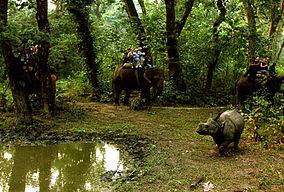Bharatpur is located on the banks of the Narayani River, and is the main town with numerous shopping zones where people come from all over the district and neighbouring districts.
Now there are about 40 Village Development Committees, each of which has nine wards or villages and one sub-Metropolitan city, Bharatpur. The Ratnanagar, Khairhani and Chitrawan municipalities have more than nine wards or urban areas.
Chitwan is one of the few remaining undisturbed vestiges of the Terai region, which formerly extended over the foothills of Nepal.
Origin
There are several predication on the origin of the name Chitwan. Some of the most satisfactory predications on the origin of its name are:
- The name Chitwan is a composite of the Sanskrit words चित्त, transliterated "citta" meaning heart and वन, transliterated "vana" meaning jungle or forest.[4][5] Thus, the meaning of Chitwan is Heart of the Jungle.
- Chitwan was a dense forest ruled by the Tharu God/King Chitrasen Baba. He used to worship in the deep forest and ruled over his state. People believe him as the incarnation of Lord Vishnu. Still today, Tharu people worship his idol duringHariBodhini Ekadashi in Chitrasari (Headquarters of Chitrasen Baba), way to Sauraha. Since the forest locally called ban (वन) was ruled by Lord Chitrasen, it was called Chitra Ban, later transliterated to Chitwan.[citation needed]
- Chitwan, still known as Dense Forest was a land of leopard and Bengal tiger. Leopard is locally called चित्रि according to Tharu language. Since the forest (वन) was densely populated by leopard or चित्रि, it was called the forest of leopard, namely चित्रि वन (Chitri Ban), later transliterated to Chitwan.[citation needed]
- Chitwan is the home land of Tharu people, who are renowned for their art and drawing. Their houses are decorated by religious drawings denoting different phases of history, culture and environment along that time. Since their homes in the forest were decorated with their drawings, locally called चित्र, the land was called चित्र वन (Chitra Ban), later transliterated toChitwan.[citation needed]
Chitwan was originally a dense forest ruled by Chitrsen Baba, where different RishiMunis came to have their meditation during ancient time with numbers of wild animals like leopard and Bengal tiger.
Agriculture and industry
The people inhabiting the Chitwan District are predominantly peasant farmers cultivating mainly food and cash crops such as rice, maize, wheat, beans, lentils, mustard andvegetables. The district is the major maize producing area in Nepal, with an area under maize cultivation of 27,170 ha (104.9 sq mi) in the year 2003-04. Maize is cultivated on irrigated /seasonal irrigated land in winter and spring, and on rain fed land in summer. Due to an easy road access, maize produced can be easily distributed to other parts of the country. The poultry industry in the district constitutes a significant proportion of the country's poultry industry.[6]
Chitwan is famous in Nepal for mustard growing and production of mustard oil. This popularity of the mustard in Chitwan is attributed to the predominant soil type silt, resulting from the flooding of the Narayani River and tributaries. Chitwan is also profusely spotted with clay lands, which are very good for growing rice, wheat and vegetables such as cabbage, cauliflower, radish, potato, broccoli, cucumbers, pumpkins, and carrot. Chitwan is also famous for floriculture, mushroom cultivation and bee keeping.
At present Bharatpur's largest business area, Narayangarh, is less accessible due to the movement of the main bus terminal due to the previous king's son's anger with the politics of the citizens of the city. This bus terminal is however no longer in use following a successful people's movement in 2006. It is believed that Nepali leftist revolutionary leader Prachanda spent his childhood and youth in Chitwan. Chitwan is adapting the New Community Movement South Korean model of development.
Cuisine
Chitwan is very popular for tasty Taas (Nepali: तास) a spicy fried goat-meat lunch dish served with Bhuja or Cheura available in many restaurants. Momo, Sukuti Khaja Set and other Newa Cuisine also available. Dal bhat is the staple food of the area, meat and dairy products are also widely consumed. For centuries, traditional fermented foods and beverages have constituted about 20 per cent of the local diet. Depending on altitudinal variation, finger millet, wheat, buckwheat, barley, vegetable, potato, and soybeans are grown.

No comments:
Post a Comment